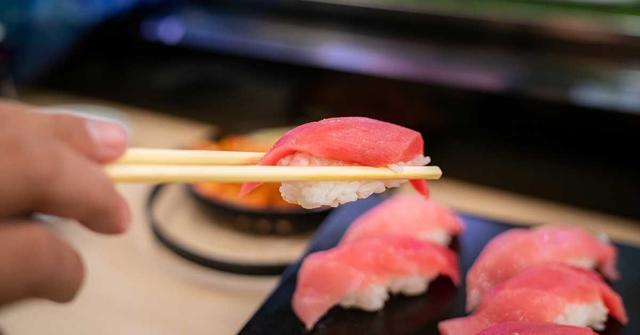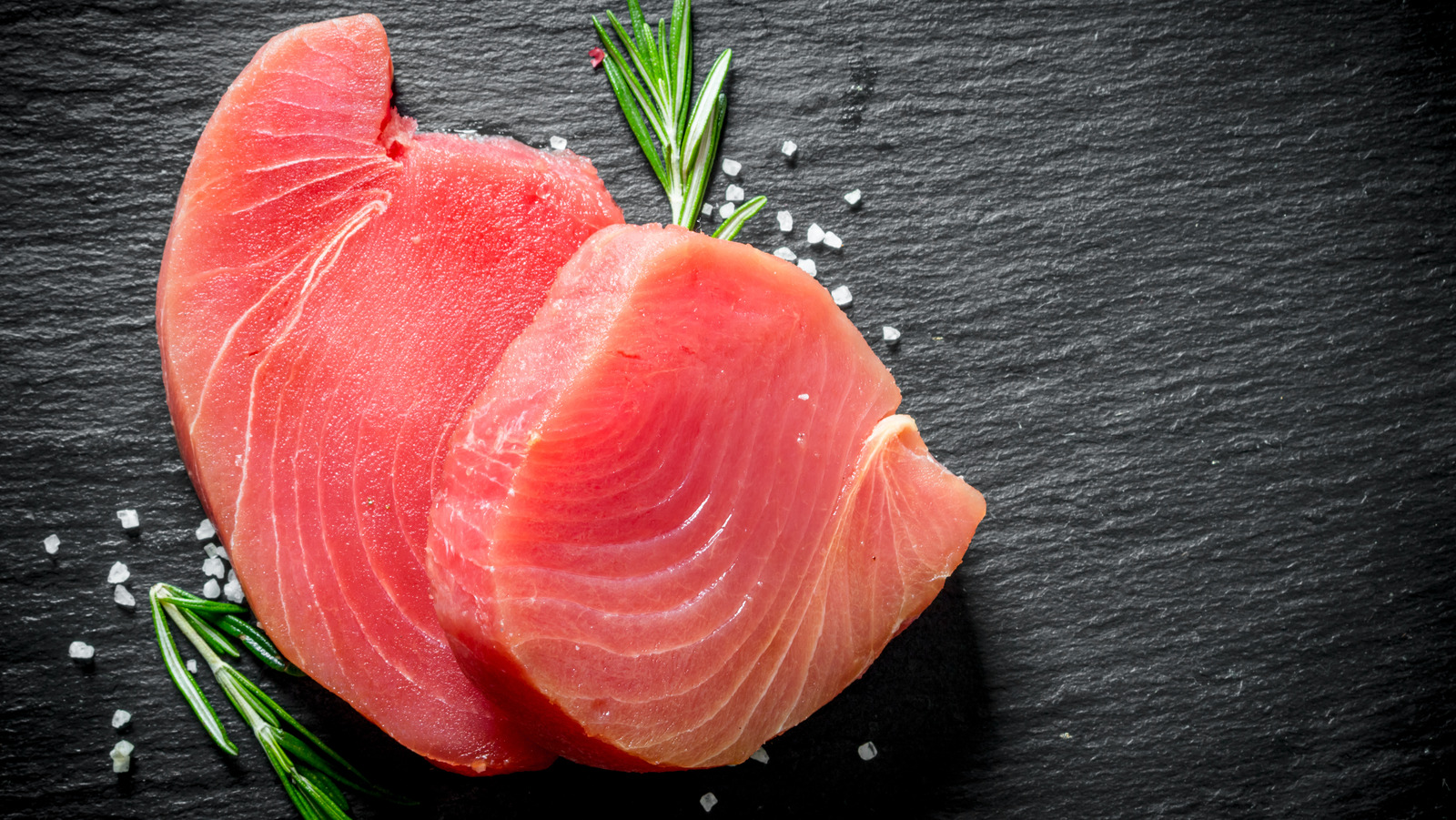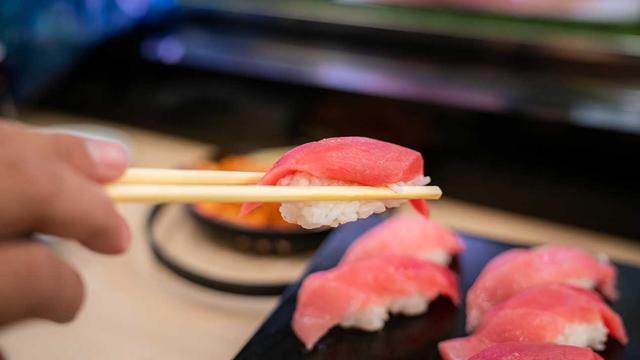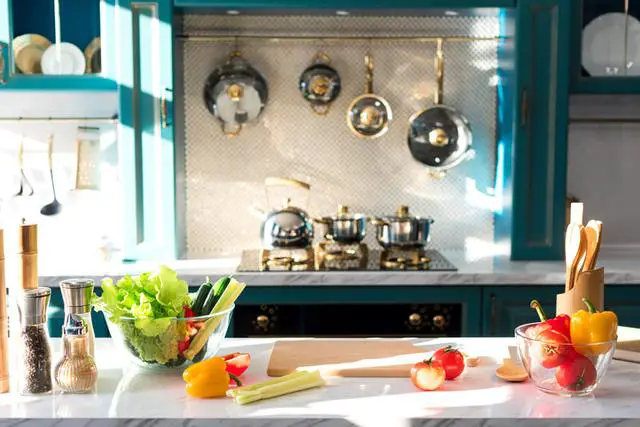
“Raw Tuna: A Delectable Delicacy Fresh from the Ocean! Discover the Exquisite Flavor and Health Benefits of this Pristine Seafood.”
Can You Eat Raw Tuna? User’s Guide on How to Safely Consume It
Eating raw tuna is both delicious and healthy, but it’s important to know how to do so safely. Raw tuna can be a versatile ingredient, but when consuming it raw, freshness is key. Look for bright red or pink flesh that is free of any discoloration or brown spots. The fish should also be firm to the touch and have a mild ocean-like smell. It’s crucial to avoid previously frozen tuna for raw consumption as it can lead to food poisoning.

Risks associated with eating raw tuna include potential mercury contamination and the risk of sushi-borne illness. Tuna, being a predatory fish, can accumulate high levels of mercury in its body. Too much mercury consumption can lead to health problems such as neurological damage and kidney failure. Additionally, some individuals may be allergic to raw tuna, experiencing symptoms like hives or difficulty breathing. Sushi-borne illnesses caused by contaminated raw fish are also a risk, so it’s important to eat at reputable sushi restaurants that use fresh fish.
Despite these risks, there are several reasons why people enjoy eating raw tuna. It is a good source of protein and omega-3 fatty acids, beneficial for heart health. It’s also low in calories and fat, making it suitable for those watching their weight. Enjoying sushi made with raw tuna can provide a unique culinary experience and an opportunity to try something new.
Can You Eat Tuna Raw?
Yes, you can eat raw tuna. In fact, raw tuna is a delicious and healthy food that is packed with nutrients. However, there are a few important considerations to keep in mind before consuming raw tuna. The key is to ensure that the fish is fresh and properly prepared.
The biggest risk associated with eating raw tuna is the potential for food poisoning. Tuna can accumulate high levels of mercury in its body, so it’s important to avoid eating too much mercury-contaminated fish. Additionally, some people may be allergic to raw tuna, and there is a risk of sushi-borne illness if the fish is contaminated. Despite these risks, raw tuna offers health benefits such as being a good source of protein and omega-3 fatty acids.
To safely consume raw tuna, it’s recommended to buy sushi-grade tuna from reputable sources. Sushi-grade fish has been flash-frozen to kill any potential parasites. It’s also important to avoid eating the skin or any dark areas of the fish as they may contain bacteria. Thoroughly washing hands and surfaces that come into contact with raw tuna is essential for preventing contamination.
What are the Risks of Eating Raw Tuna?
Eating raw tuna can pose several risks, including the potential for food poisoning. Tuna is a predatory fish that can accumulate high levels of mercury, which can lead to health problems if consumed in large quantities. It’s important to only eat properly prepared and fresh tuna to avoid these risks.
In addition, some individuals may be allergic to raw tuna, experiencing symptoms such as hives, swelling, difficulty breathing, and anaphylaxis. It’s crucial for those with fish allergies to avoid consuming raw tuna or any other type of fish.
There is also a risk of sushi-borne illness caused by consuming contaminated raw fish. To prevent this type of food poisoning, it’s essential to eat at reputable sushi restaurants that use fresh, high-quality fish.
Food Poisoning
Raw tuna carries the risk of food poisoning due to potential contamination. Tuna is a predatory fish that can accumulate high levels of mercury in its body, which can lead to health problems if consumed in excess. Additionally, consuming contaminated raw fish can result in sushi-borne illness, causing symptoms such as nausea, vomiting, and diarrhea. To minimize these risks, it is crucial to only consume properly prepared and fresh tuna from reputable sources.
Allergies
Some individuals may have allergies to raw tuna. Symptoms of a tuna allergy can include hives, swelling, difficulty breathing, and anaphylaxis. If you are allergic to fish, it is important to avoid consuming raw tuna or any other type of fish.
Sushi-borne Illness
Sushi-borne illness is a type of food poisoning that can occur from consuming contaminated raw fish, including raw tuna. Symptoms of sushi-borne illness can include nausea, vomiting, and diarrhea. To reduce the risk of sushi-borne illness, it is important to only eat at reputable sushi restaurants that use fresh, high-quality fish.
Proper handling and storage of raw fish are also essential in preventing sushi-borne illness. Sushi chefs should follow strict hygiene practices, such as regularly cleaning utensils and surfaces, using gloves when handling raw fish, and properly storing the fish at the correct temperature. Consumers should also ensure that they are eating sushi from trusted sources to minimize the risk of contamination.
Why Do People Eat Raw Tuna?
There are several reasons why people enjoy eating raw tuna. First, raw tuna offers a unique culinary experience. The delicate texture and mild, ocean-like flavor of raw tuna can be a refreshing change from cooked fish. This makes it a popular choice for sushi lovers who appreciate the fresh taste and smooth mouthfeel of raw seafood.
In addition to its delicious taste, raw tuna is also valued for its health benefits. Tuna is a good source of protein and omega-3 fatty acids, which are important for heart health. It is also low in calories and fat, making it a healthy option for those watching their weight. The nutrients found in raw tuna, such as vitamins B6 and B12, selenium, and potassium, contribute to overall well-being and support brain function.
Nutrition
Raw tuna is not only delicious, but it also offers several nutritional benefits. It is a great source of protein, which is essential for building and repairing tissues in the body. Protein also helps to keep you feeling full and satisfied, making raw tuna a good option for those looking to manage their weight.
In addition to protein, raw tuna is rich in omega-3 fatty acids. These healthy fats are known for their heart-healthy benefits, as they can help reduce inflammation and lower the risk of heart disease. Omega-3 fatty acids are also important for brain health and may help improve cognitive function.
Raw tuna is low in calories and fat, making it a nutritious choice for those watching their calorie intake. It is also a good source of vitamins and minerals such as vitamin D, vitamin B12, selenium, and potassium.
Unique Culinary Experience
Eating raw tuna can provide a unique culinary experience that is different from other cooking methods. The texture of raw tuna is tender and buttery, while the flavor is rich and delicate. It allows you to fully appreciate the natural taste of the fish without any added seasonings or sauces. Sushi, which often features raw tuna as a key ingredient, offers a combination of flavors and textures that can be both refreshing and satisfying. The combination of raw fish, rice, and vegetables creates a harmonious balance that is pleasing to the palate.
In order to have a truly enjoyable raw tuna experience, it is important to ensure the fish is fresh and of high quality. When selecting tuna for consumption, look for bright red or pink flesh that is free of any brown spots or discoloration. The fish should also be firm to the touch and have a mild, ocean-like smell. By choosing fresh and high-quality tuna, you can enhance your culinary experience by savoring the natural flavors of the fish.
How to Safely Eat Raw Tuna

When it comes to enjoying raw tuna, there are a few important guidelines to follow to ensure your safety. First and foremost, make sure to purchase sushi-grade tuna from a reputable source. Sushi-grade tuna has been flash-frozen, which helps eliminate any potential parasites that may be present in the fish. This type of tuna is safe to eat raw and is commonly found at sushi restaurants or specialty markets.
It is also crucial to avoid consuming the skin or any dark areas of the fish, as these parts may contain bacteria. To minimize the risk of foodborne illnesses, thoroughly wash your hands and all surfaces that come into contact with the raw tuna. Additionally, be mindful of the freshness of the fish you select for consumption. Look for bright red or pink flesh that is free of any discoloration or brown spots.
By following these simple guidelines, you can enjoy the unique culinary experience and health benefits of eating raw tuna without compromising your safety.
FAQs
1. Can you eat raw tuna steak from the grocery store?
It is not recommended to eat raw tuna steak from the grocery store unless it is labeled as sushi-grade. Sushi-grade tuna has been flash-frozen to kill any potential parasites and is safe to consume raw.
2. What are the risks associated with eating raw tuna?
The biggest risk of consuming raw tuna is food poisoning, as tuna can accumulate high levels of mercury in its body. Other risks include allergies to raw fish and sushi-borne illnesses caused by contaminated fish.
3. What are the health benefits of eating raw tuna?
Eating raw tuna can provide essential nutrients like protein and omega-3 fatty acids, which are beneficial for heart health. It is also low in calories and fat, making it a healthy option for those watching their weight.
4. How can I ensure the safety of consuming raw tuna?
To safely consume raw tuna, it’s important to buy sushi-grade fish from a reputable source. Avoid eating the skin or any dark areas of the fish, as they may contain bacteria. Thoroughly wash hands and all surfaces that come into contact with raw tuna.
5. Is all tuna sushi grade?
No, not all types of tuna are sushi grade. Sushi-grade tuna has been flash-frozen to eliminate parasites and ensure safety for raw consumption.
Which fish can not be eaten raw?
There are a few types of fish that should not be eaten raw due to the risk of food poisonings, such as tuna, salmon, and mackerel. These fish can accumulate high levels of mercury in their body, which can be harmful if consumed in large quantities.
Is all tuna sushi grade?
No, not all tuna is sushi grade. Sushi-grade tuna is a type of tuna that has been flash-frozen to kill any potential parasites. This type of fish is safe to eat raw and is typically found at sushi restaurants or specialty markets. It’s not recommended to eat raw tuna steak from the grocery store because it’s not sushi grade and may contain parasites. If you’re looking to eat raw tuna, it’s best to buy sushi-grade fish from a reputable source.
Can you eat raw tuna steak from the grocery store?
Eating raw tuna steak from the grocery store is not recommended, as it is not sushi-grade and may contain parasites. Sushi-grade tuna is a type of fish that has been flash-frozen to kill any potential parasites, making it safe to eat raw. To ensure your safety when consuming raw tuna, it is best to buy sushi-grade fish from a reputable source.
Conclusion

In conclusion, raw tuna can be a delicious and healthy food option if consumed safely. It is important to ensure that the tuna is fresh and properly prepared before consuming it raw. Look for bright red or pink flesh that is free of any discoloration, and avoid eating tuna that has been frozen or previously frozen.
While there are some risks associated with consuming raw tuna, such as the potential for food poisoning and allergies, these risks can be minimized by buying sushi-grade tuna from reputable sources and avoiding any dark areas of the fish. Additionally, raw tuna offers health benefits such as being a good source of protein and omega-3 fatty acids.
If you enjoy sushi or want to try something new, raw tuna can provide a unique culinary experience. By following simple guidelines like washing hands and surfaces thoroughly, you can safely enjoy the delicious taste of raw tuna without any complications.
In conclusion, raw tuna is a versatile and nutritious seafood option that offers a unique and delicate flavor. It is commonly used in dishes like sushi and sashimi, providing a rich source of omega-3 fatty acids and high-quality protein. However, it is essential to handle raw tuna with care due to potential foodborne illnesses. When sourced from reputable suppliers and prepared safely, raw tuna can be enjoyed as a delicious addition to a balanced diet.
Learn More About Grilling
If you want to learn more about grilling, check out these other helpful resources!










